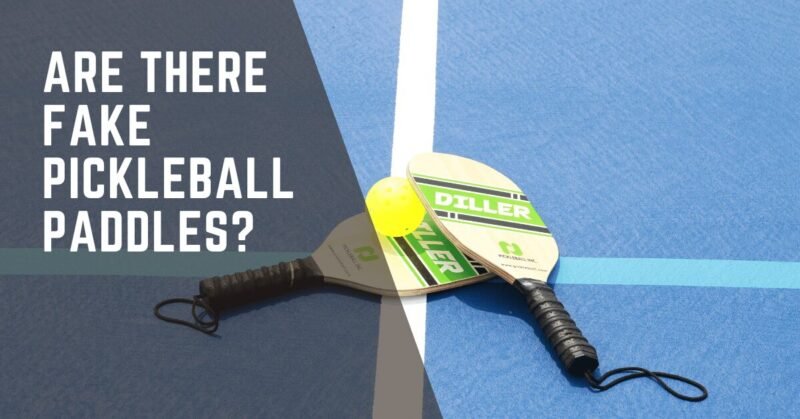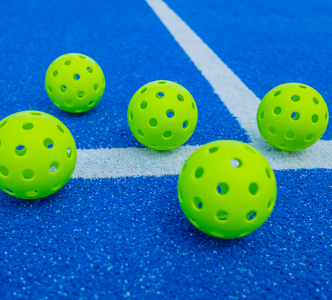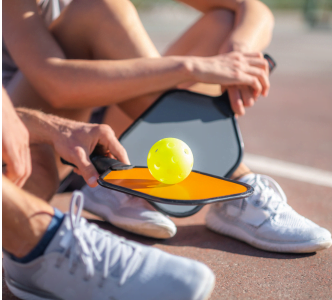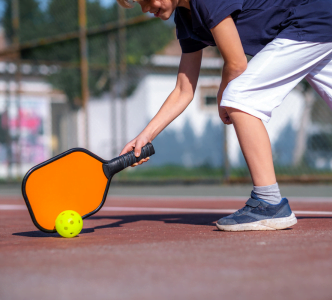Starting your pickleball journey? Fantastic! But before you ace your first volley, let’s talk about your tool of the trade: the paddle. It plays a bigger role than you might think, and selecting a high-quality, authentic paddle is crucial for optimal performance and safety.
Imagine your paddle as an extension of your hand, guiding you to victory shots. However, like other sports, pickleball can be plagued by fake pickleball paddles. These low-quality imitations promise big swings but often lead to frustrating gameplay and even potential injury.
Worry not! This guide will equip you with the knowledge to choose the perfect paddle. We’ll explore the evolution of paddles, the significance of quality and authenticity, and guide you towards selecting the best one for your playing style.
The Evolution of Paddle Design
Pickleball paddles have come a long way since the sport began. Initially, they were simple, made from wood and without much variety. Over time, manufacturers started experimenting with new materials and designs to improve performance.
The introduction of materials like graphite and composite has revolutionized paddle design. These materials made paddles lighter and stronger, enhancing the game for players of all levels. Additionally, the design of paddles evolved to include features like different shapes and grip sizes to suit individual preferences.
One significant change was the discussion around the legality of holes in paddles. While traditional paddles were solid, some modern designs include holes to reduce weight and improve aerodynamics. This innovation sparked debates, but as long as paddles meet official specifications, they’re considered legal for play.
The Rise of Bogus Pickleball Paddles
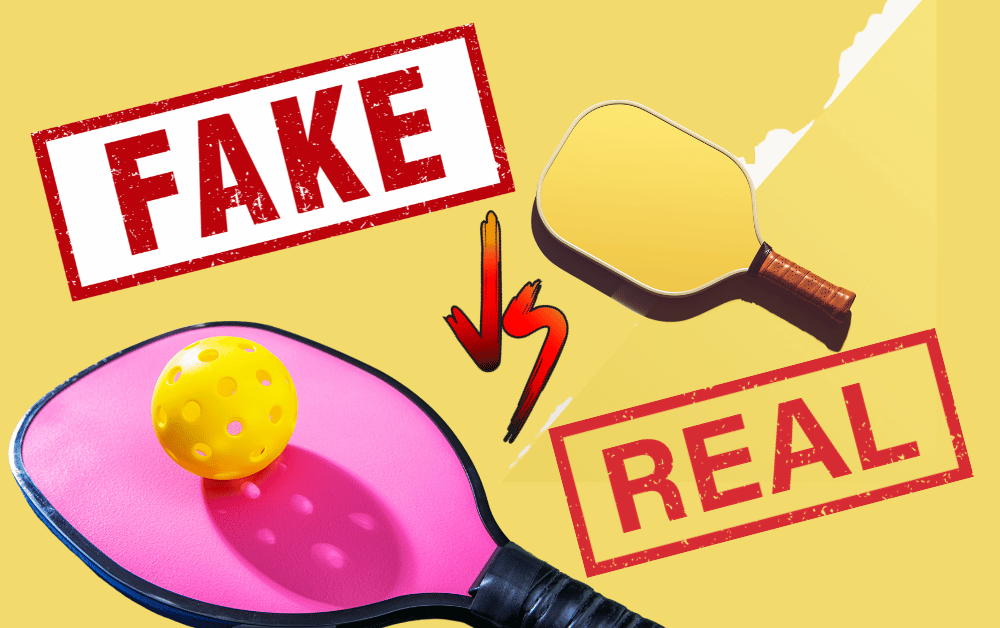
Fake pickleball paddles have started to pop up more and more. They sneak into the market, mainly through online shops, tempting players with their low prices. But, the excitement fades fast when the quality reveals itself.
Trusted brands like Selkirk, Engage, and Franklin have developed innovative designs. They have also started using space-age materials in their performance paddles. This led to a cult following and premium prices.
Several overseas manufacturers saw dollar signs. They started making cheap “knock-off” versions to fool buyers. The knock-offs looked like the $200+ paddle but cost only $80. I have to admit, that would trick me too!
These counterfeit paddles often get mixed into inventory at popular online shops. What’s worse, they seem to do it frequently. Buyers can end up with fake paddles without realizing it. They might not recognize the scam until they unbox their expensive “bargains.” Utterly shocking stuff is going on.
A good thing is that some pickleball paddles are manufactured in the United States, but that doesn’t mean they can’t be counterfeited.
Why Fake Paddles Are a Problem
Knockoff pickleball paddles aren’t just a minor nuisance; they’re a big problem. They can mess with a player’s game, affecting everything from swing to accuracy. This not only hurts performance but also the fairness and integrity of the game.
There’s also a safety angle. Poorly made paddles can break easily, possibly causing injuries. Imagine going for a powerful serve only to have your paddle snap. It’s not just disappointing; it’s dangerous.
Lastly, there’s the matter of legality and ethics. Selling or buying fake sports equipment is against the law and goes against the spirit of fair play in the pickleball community. It’s about respecting the game and each other.
How to Identify Fake Pickleball Paddles
Spotting a fake pickleball paddle can be easier if you know what to look for. Visual cues are your first clue. Counterfeit paddles often have slight differences in colour, logo size, or placement compared to the real thing. The quality of the printing might be poor, with logos looking blurry or peeling off.
Physical indicators are just as telling. The weight of the paddle can be a dead giveaway; if it feels too light or too heavy, it might not be genuine. The texture and material quality can also differ, with fake paddles feeling cheaper or not as durable as they should be.
Genuine paddles have a certain standard of craftsmanship and quality that fakes just can’t match. Authentic paddles are designed to meet specific playing standards, with attention to detail in their construction. By comparing the paddle in question with known genuine products, players can often tell the difference, ensuring they’re playing with the best equipment possible.
How to Verify Authentic Pickleball Paddles
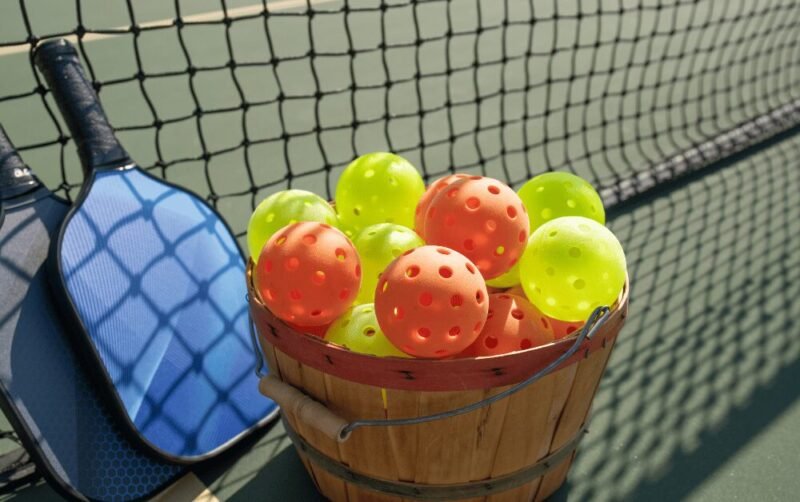
To make sure you’re getting a real deal, look for official certifications on pickleball paddles. These certifications, like those from the USA Pickleball Association, confirm a paddle meets certain standards. They’re a big deal because they guarantee the paddle is game-ready and safe to use.
Next, get to know the trusted names in pickleball. Brands like Selkirk, Paddletek, and Onix have earned their stripes for quality and reliability. Sticking with these well-known manufacturers can steer you clear of fakes.
Finally, pay attention to where you’re buying from. Authorized retailers have a direct relationship with manufacturers, ensuring authenticity. They often have processes in place to verify each paddle’s legitimacy. Buying from these sources gives you peace of mind that you’re getting the genuine article.
Also, read The difference between pickleball paddles so you can identify which pickleball paddles are good for you whether you are a beginner intermediate or advanced player.
Tips for Avoiding Fraudulent Pickleball Paddles
When looking to buy a pickleball paddle, sticking to reputable sources is key. Opt for well-known sports stores, official brand websites, or authorized dealers. These places are less likely to carry counterfeit items, giving you peace of mind with your purchase.
Be vigilant for red flags, whether shopping online or in person. Unrealistically low prices, poor-quality images, or lack of detailed product information can all signal a fake. Also, watch out for sellers with no return policy or bad reviews.
What to Do If You Purchase a Fake Paddle
If you end up with a counterfeit paddle, it’s important to act. Start by reporting the product to the authorities and the brand being imitated. They’re interested in stopping counterfeits to protect their reputation and customers.
Next, try to get a refund or replacement. Contact the seller directly if you bought the paddle online. If that doesn’t work, you might need to dispute the charge with your credit card company. Remember, keeping detailed records of your purchase and communications can help your case.
Conclusion
The world of pickleball paddles requires vigilance to ensure you’re getting the real deal. By understanding the signs of counterfeit products, knowing where to shop, and being aware of the red flags, you can protect yourself from fake pickleball paddles. If you do end up with a counterfeit, it’s important to know the steps to take, from reporting the issue to seeking a refund or replacement. Remember, investing in authentic pickleball equipment not only enhances your performance but also supports the integrity of the sport. Stay informed, stay safe, and enjoy the game with genuine gear.
FAQ’s
Are there illegal pickleball paddles?
Yes, there are illegal pickleball paddles. Paddles that don’t meet the specifications set by the USA Pickleball Association (USAPA) for size, material, and surface texture are considered illegal for official tournament play. These regulations ensure fairness and consistency in the game.
How can you tell if a pickleball paddle is bad?
You can tell if a pickleball paddle is bad if it shows signs of wear such as cracks, dents, or a softening of the surface which can affect play. Additionally, a significant change in sound or a decrease in the paddle’s responsiveness during play can indicate it’s time for a replacement.
How do you identify a pickleball paddle?
You can identify a pickleball paddle by examining its specifications, such as material (wood, composite, or graphite), weight, grip size, and dimensions. Authentic paddles often have brand markings and may include USAPA approval stamps if they meet official standards.
Is there really a difference between pickleball paddles?
Yes, there is a significant difference between pickleball paddles. Differences in materials, weight, and design can affect a paddle’s durability, playability, and suitability for different skill levels and playing styles. Choosing the right paddle can greatly impact your performance and enjoyment of the game.
What is an official pickleball paddle?
An official pickleball paddle meets the specifications and standards set by the USA Pickleball Association (USAPA). These standards include dimensions, material, and surface texture. Official paddles are eligible for use in sanctioned tournaments and are designed to ensure a fair and consistent playing experience.
Does TSA allow pickleball paddles?
Yes, the Transportation Security Administration (TSA) allows pickleball paddles in both carry-on and checked baggage. However, it’s always a good idea to check the latest TSA guidelines and airline policies before traveling, as regulations can change.

